The Hyundai Kona Electric is the second-best selling electric car in the first-half of 2022, but amid new entrants from MG, BYD and Tesla, does this South Korean small SUV still hold up against the competition?
With nearly 17,000km put on the clock from tireless reviews and a long-term loan by other media, this is also an opportunity to assess how well it’s aged as an used electric car.
The Kona Electric is available in two model grades, two battery pack sizes and two front-wheel driven electric motors after receiving a mid-life refresh in 2021.
Here, we’re testing the flagship Highlander Extended Range, priced from $64,000 before on-road costs. It is painted in Dive in Jeju (no cost extra) with the optional black/grey interior ($295) and Hyundai also supplied us with a Type 2 to Type 2 charging cable accessory ($495) to use at public AC charging stations.
For full pricing, specifications and features of the 2022 Hyundai Kona Electric, click here.
zecar rating
Good points
- No-nonsense interior and tech
- Crazy good efficiency
- Good size for city driving
Could be better
- Too much power for FWD’s sake
- Limited rear passenger space
- The competition has moved a step forward
EDITOR’S NOTE: The test vehicle was provided by Hyundai Australia for a seven-day independent evaluation.
Design
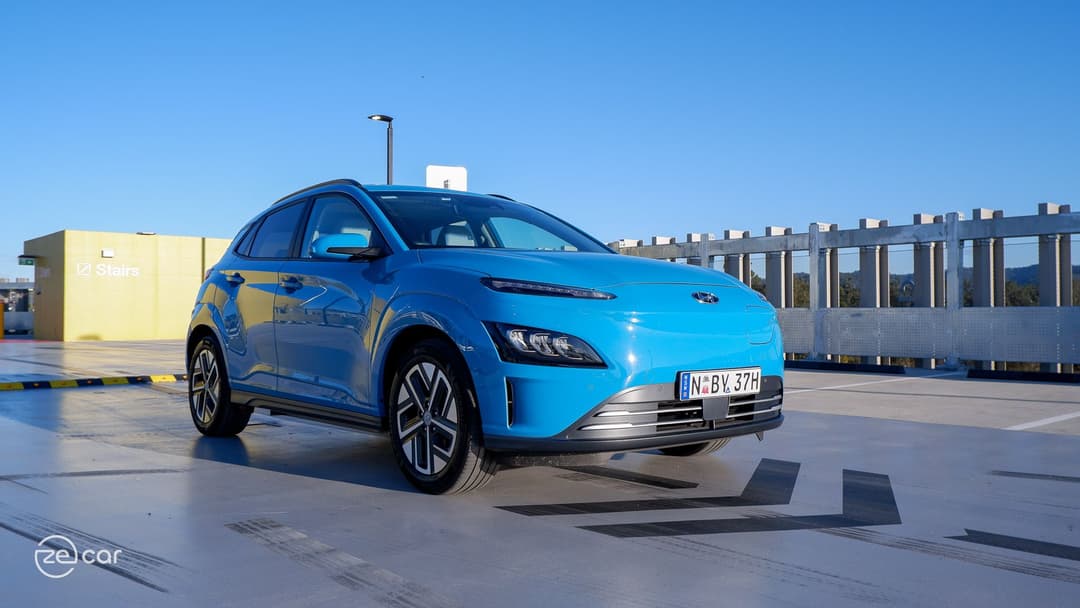
While someone said to me 'it's just another Kona', I was surprised that the Kona Electric turned many heads during the week.
It might be the bright Dive in Jeju colourway, facelifted cute asymmetrical smooth front face, quirky front charging port lid, Iron Man-inspired LED lights, futuristic pedestrian warning sound or proud 'electric' tailgate badge; there were many curious people glancing at the zero tailpipe small SUV.
And yes, our test example is finished in the free-of-charge Dive in Jeju, despite looking akin to Surfy Blue and nothing like Hyundai's rendering on its website.
It might not be as avant garde as the bespoke Hyundai Ioniq 5, but the Kona Electric strikes a balance between being a little quirky and not boring. Though, sometimes I wish it looked like the aggressive, boy-racer Kona N instead.
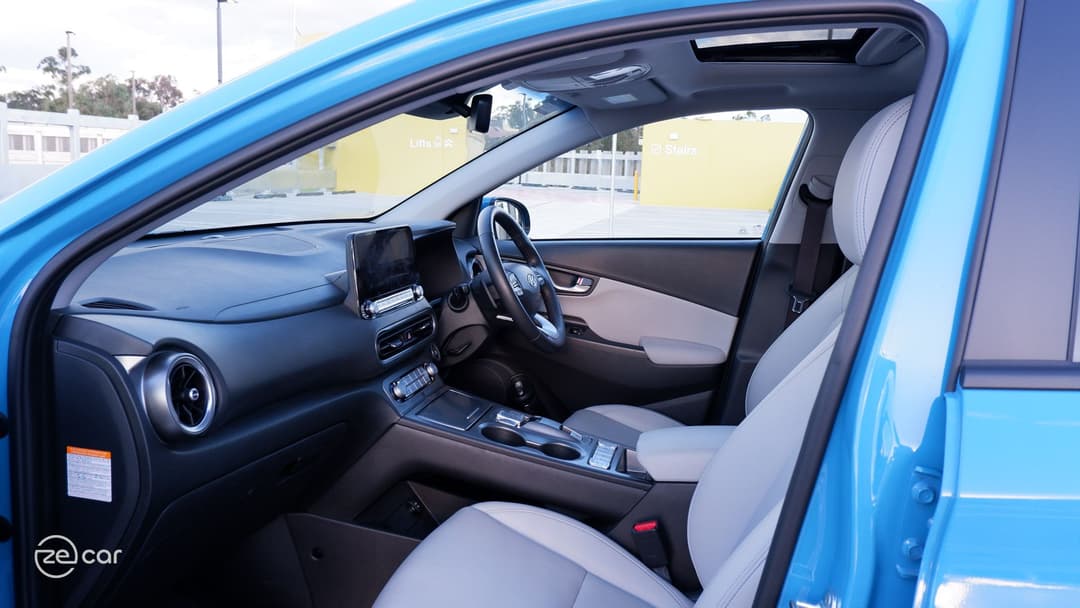
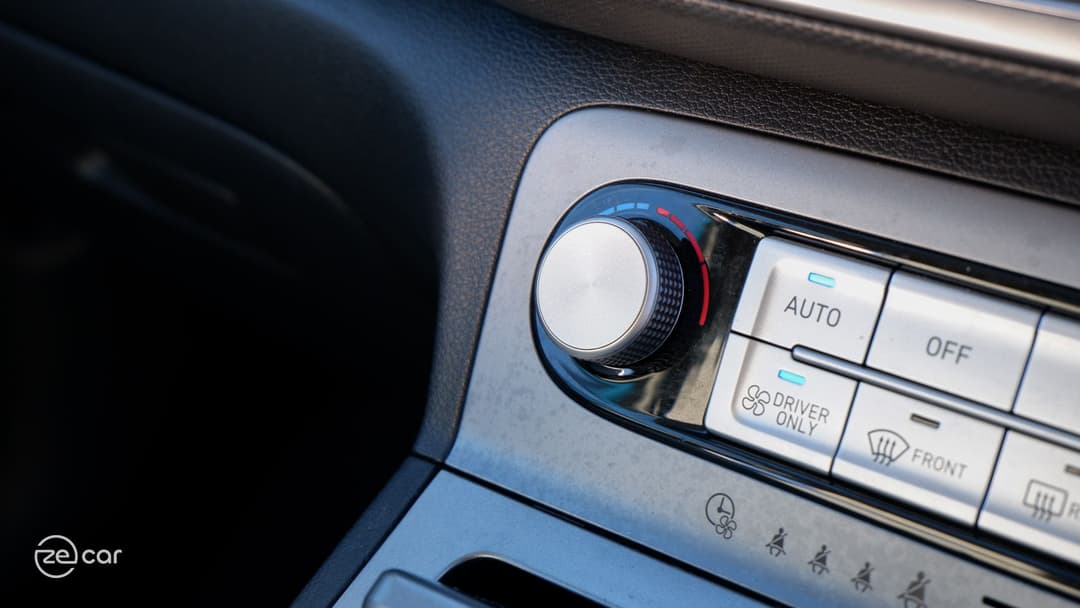
Inside it's a functional, no-thrills design. Our unit had the optional black/grey interior, which looks more like an off-white with discreet blue stitching, and lifts the interior up a notch.
It is solidly put together, but doesn't have the perceived 'premium' quality feel with hard textured plastics and minimal use of gloss black surfaces that gives off more of a rugged and durable impression.
However, with around 17,000km already driven, there were some marks on the white seats and door, plus some weird staining spots on the silver trim around the HVAC controls.
Although it's not the most exciting interior, it is simple and functional – physical buttons and dials for the climate control and a prominent centre console divider finished in a retro-like satin silver that is unique to the Kona Electric.
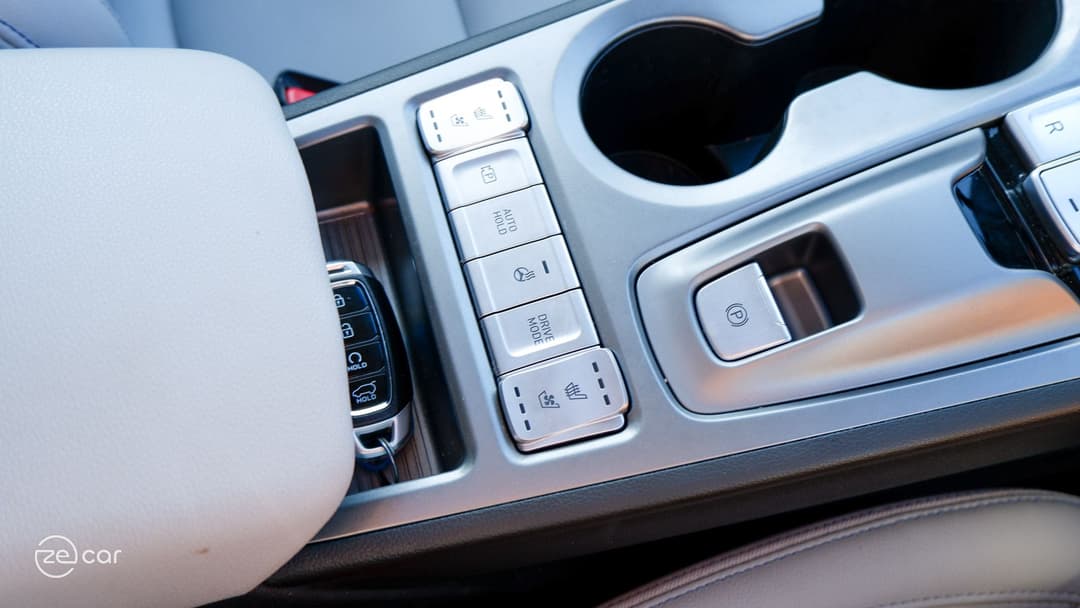
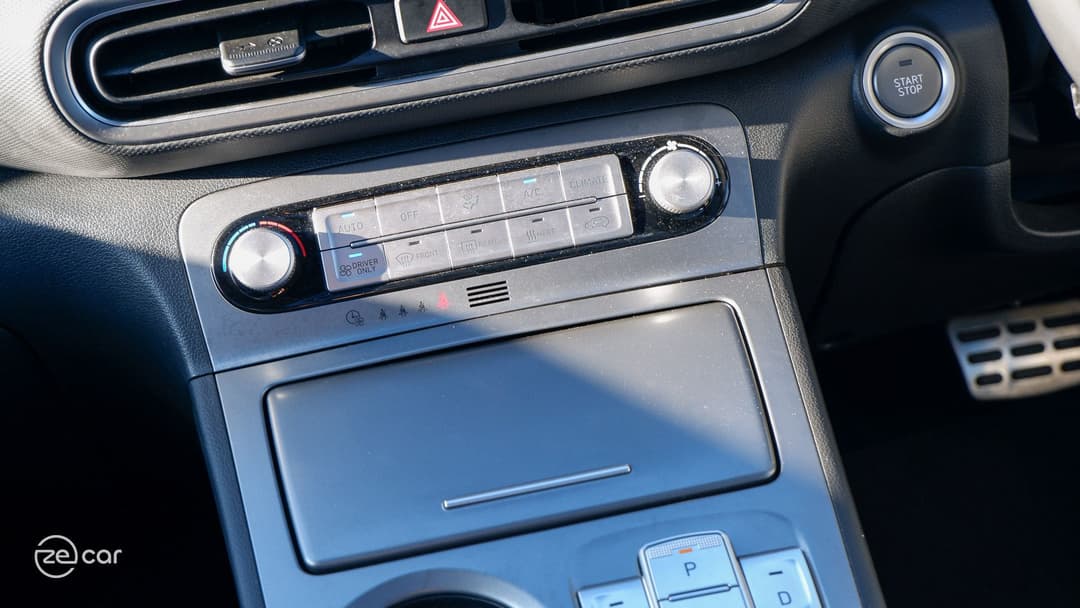
There are tactile blocky buttons to immediately turn off the air-con or instantly defog the windscreen. The climate controls don’t have a temperature display; instead, it shows HVAC adjustments on the touchscreen which is a good balance between physical and digital.
But, the row of switches to toggle the auto hold, drive modes, heated steering wheel, and ventilated/heated front seats are set a little too far back for the driver to glance and press quickly while driving.
Practicality
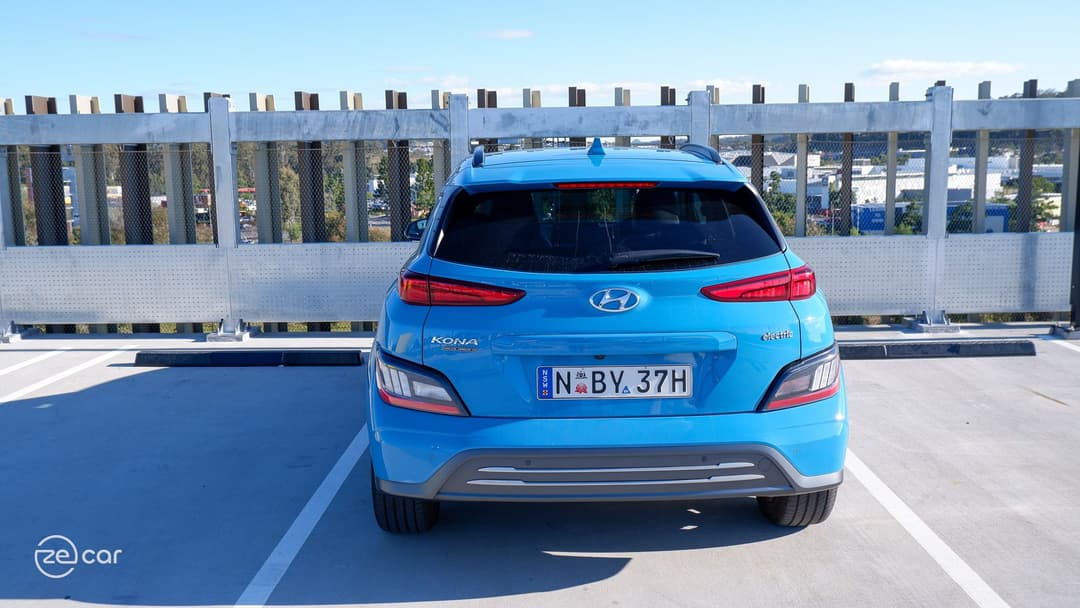
The Hyundai Kona Electric has 332-litres of boot space or 1114-litres when the rear seats are folded down in a 60/40 configuration. It’s enough for groceries and shopping, but it’s a struggle for anything else more demanding. While there’s one bag hook, its low position and flat load floor means it’s only useful for smaller bags.
Due to the lack of a spare tyre, there's a deep well under the boot floor to house Hyundai's own bag that fits the supplied three-pin domestic charging cable. Unfortunately, if you also buy an optional Type 2 to Type 2 cable, it needs to take up boot space and the crossover also doesn't offer a frunk.
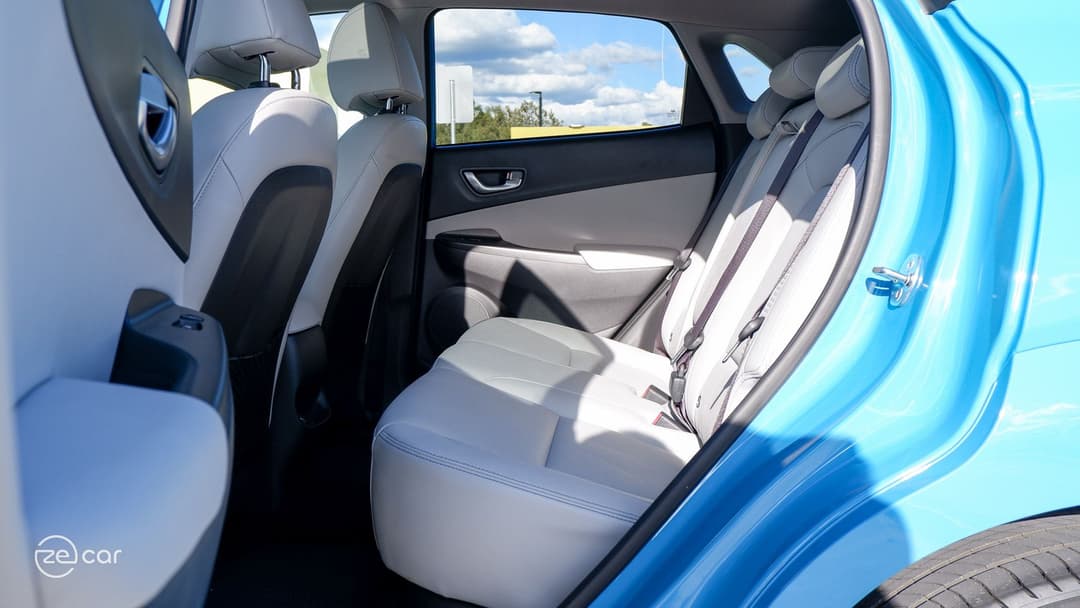
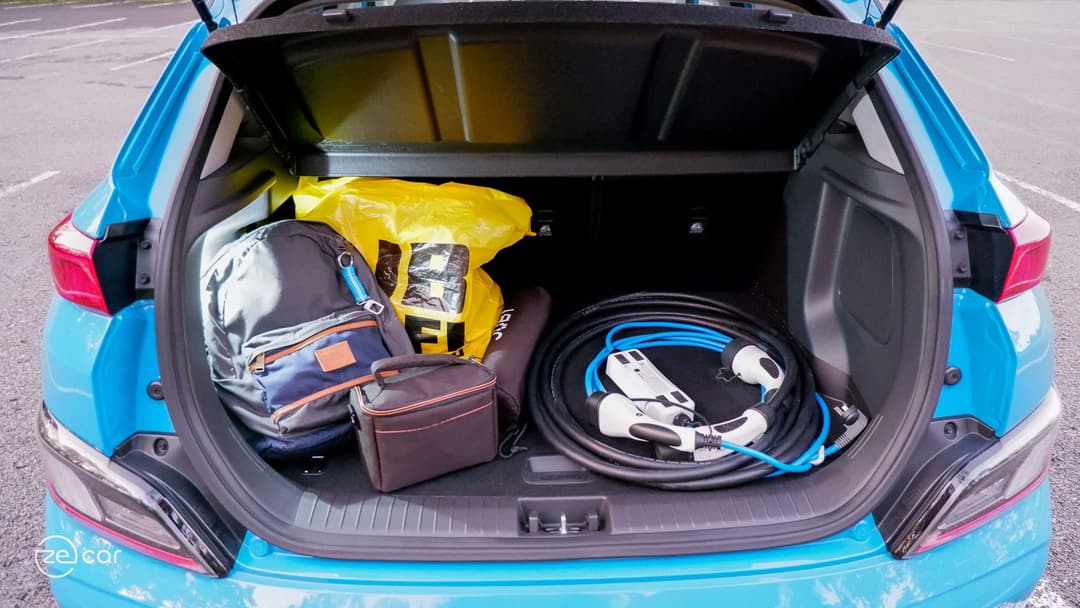
With my ∼180cm slim stature and driving position, the rear row seats provide just enough head and leg room to sit comfortably. However, taller or bigger frame passengers will struggle at the back for even short trips. That’s no surprise given the Kona Electric’s compact dimensions that undercuts the MG ZS EV and Kia Niro EV.
Rear passengers are also treated with heated outer seats, a fold-down centre armrest with two cup holders, and a minimal protruding middle floor hump as a remnant of its combustion engine platform origins. Rear air vents are missing, but the interior is small enough to circulate the climate control.
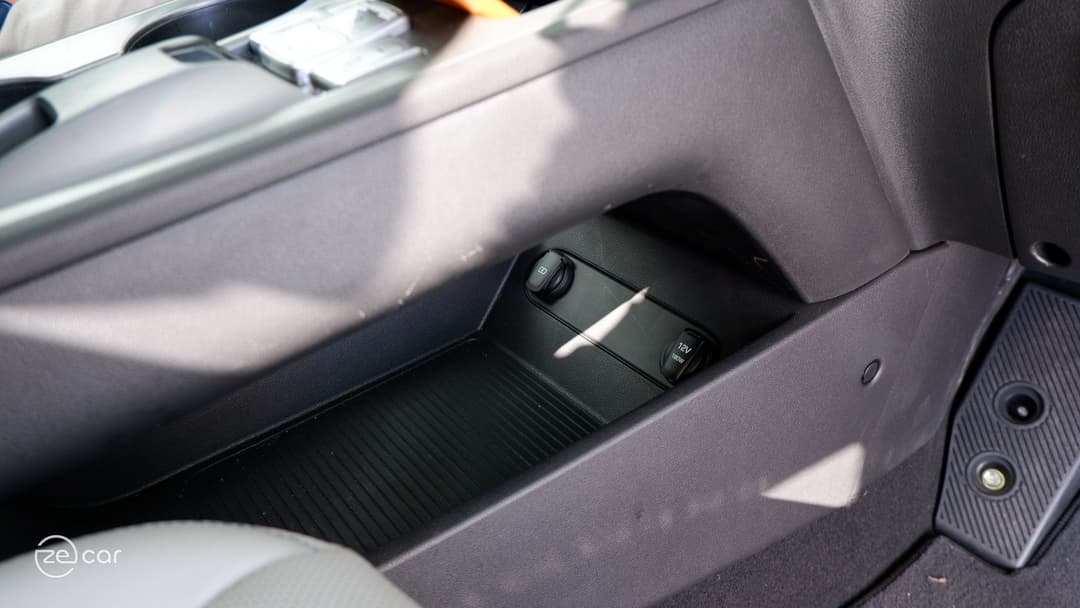
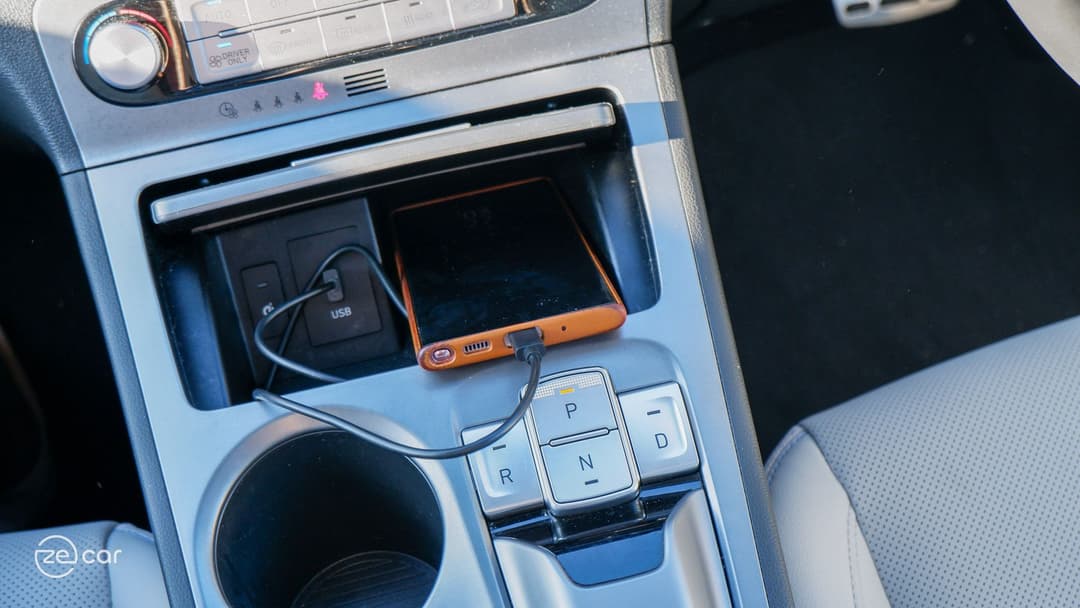
Up the front, the centre console elevates up to divide the driver and passenger with two cup holders, a slot to put the proximity key, deep centre armrest storage and even a dedicated large open tray underneath. Though, as it’s quite hidden, anything stored in there can easily be forgotten.
There’s also a deep spot to put a smartphone with a closable lid. Even for my massive 6.9-inch Samsung Galaxy Note20 Ultra, it just fits the Qi wireless charging pad and I can just lean it on an angle while plugged into the USB-A to avoid the said pad.
Technology
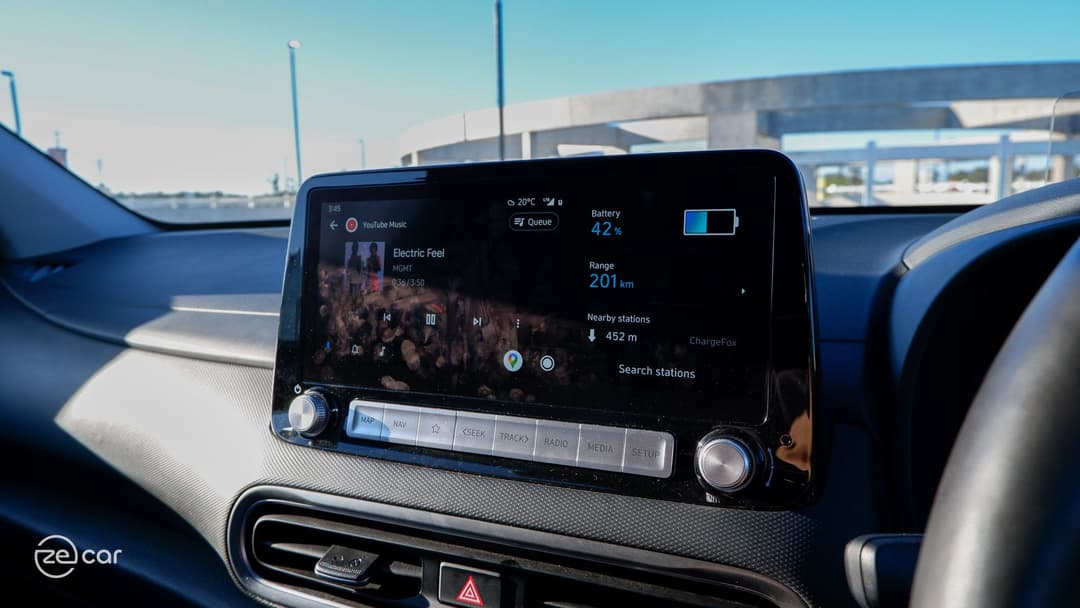
The Hyundai Kona Electric comes standard with a 10.25-inch windscreen infotainment system and 10.25-inch driver’s display thanks to the facelift.
I like how the touchscreen protrudes from the dash as it’s in the driver’s line of sight and easy to glance for navigation directions or the HVAC controls while driving. The LCD display is overall clear with a good resolution, black levels and a fingerprint-resistant matte coating.
The Hyundai Motor Group’s own operating system boots up quickly, the interface looks modern and has a reasonably intuitive interface. It offers built-in maps with public EV charger information, speed limit and road hazard warnings – albeit not always up-to-date – a climate app to see the HVAC settings,‘Sounds of Nature’ to play ambient noises and more.
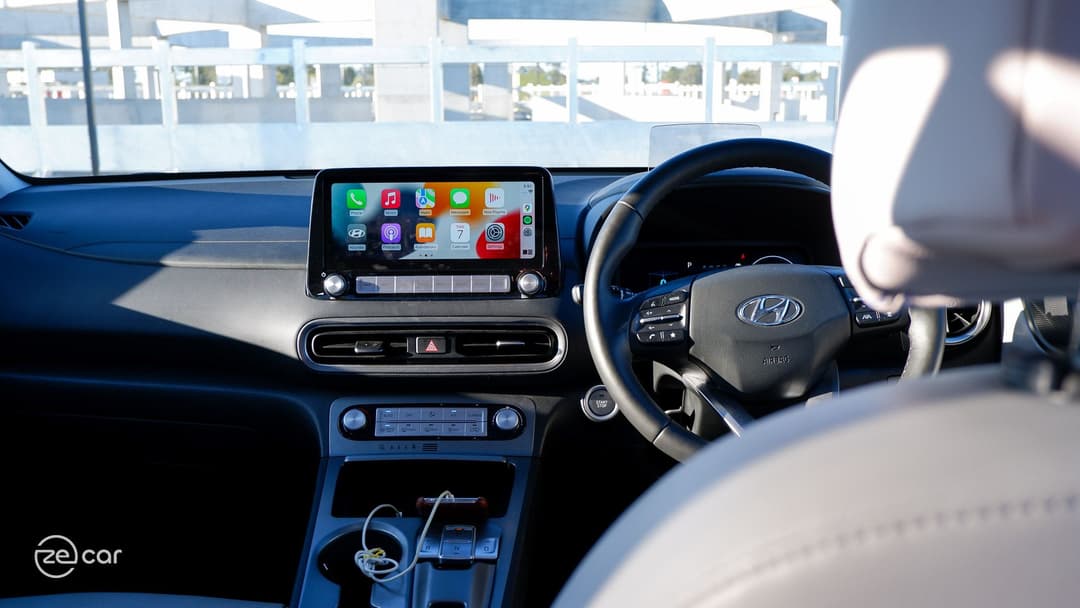
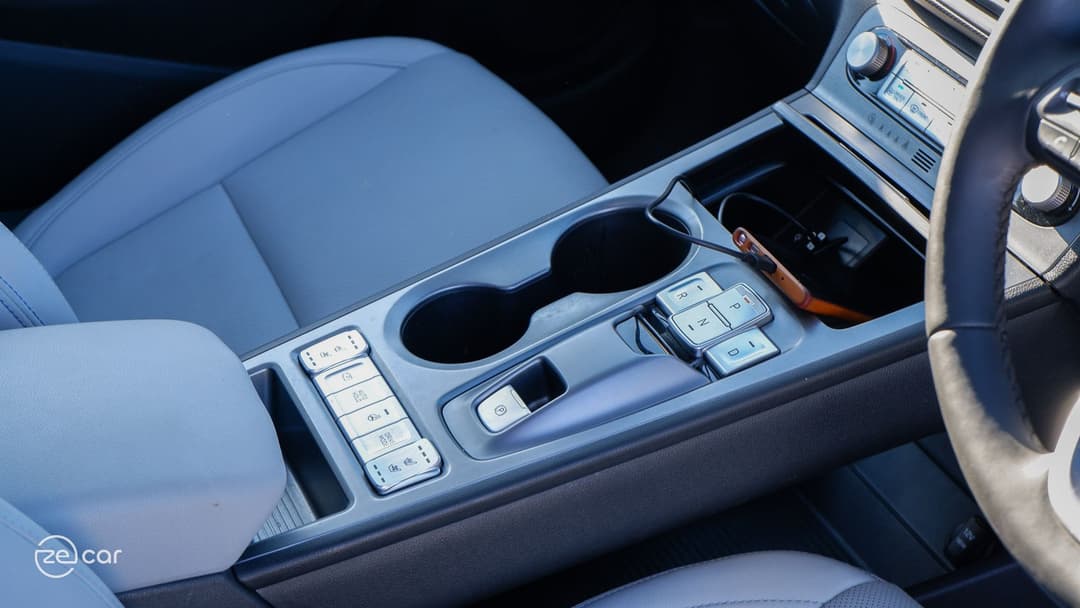
The remaining battery percentage number isn’t displayed in the infotainment system’s main screen nor the digital instrument cluster. Instead, owners need to use the split-screen mode widget or open the dedicated EV app – which also displays an estimated range map, amount of carbon dioxide emissions saved per trip, set charging limits and more.
Importantly, the battery-electric crossover features wired Apple CarPlay and wired Android Auto via an USB-A port that charges phones quickly, too. Both tech giants utilise the full windscreen, though the latter wasn’t possible yet in our tester as the update was only recently released.
Meanwhile, the fully-digital driver’s cluster clearly fuses the EV world with traditional combustion engine traits. It displays two dials – speed and a regen/power metre – plus changeable pages in the centre. Within those dials, it outlines the battery state of charge and regenerative braking level mode akin to a fuel gauge.
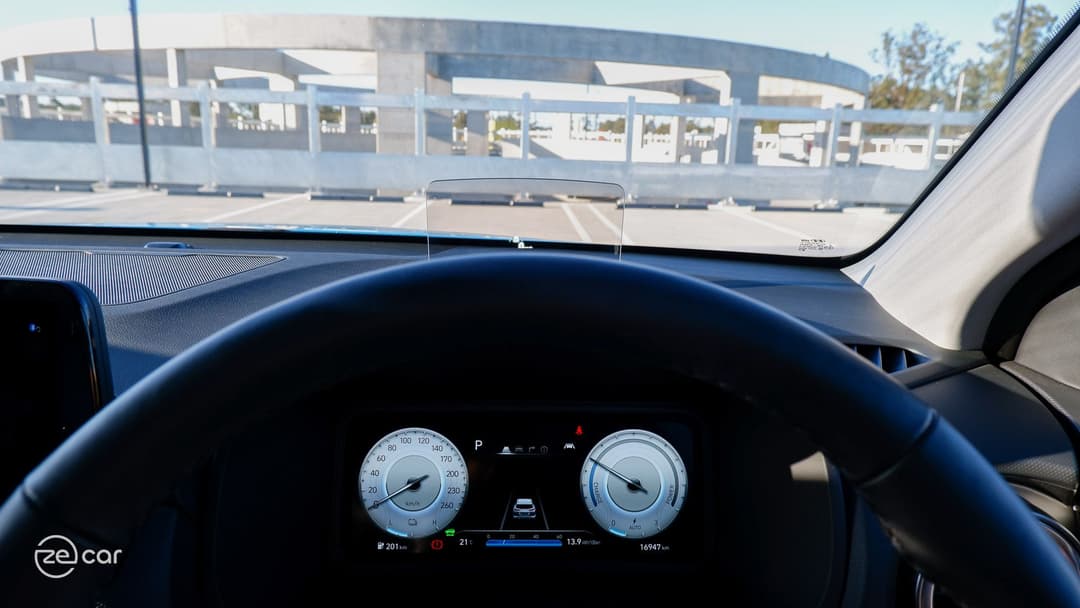
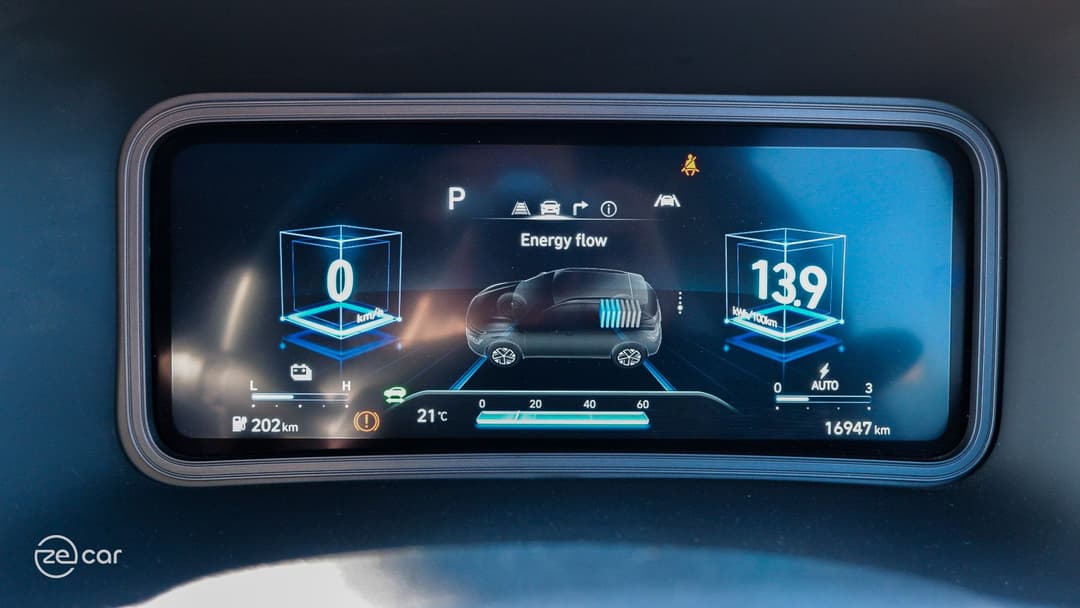
Despite its traditional roots, I prefer these instruments as they’re somewhat customisable; the dials and fonts change colour according to the drive mode and there’s a separate futuristic digital ‘cyber’ theme.
This top-spec Highlander variant gains a flip-up head-up display (HUD) which is handy for looking at the digital speedometer – freeing up space to show other screens in the instrument display – plus speed limit, safety assist warnings and playing audio.
All models come with an eight-speaker Harman Kardon sound system, which sounds relatively average for music and podcasts.
Safety assist
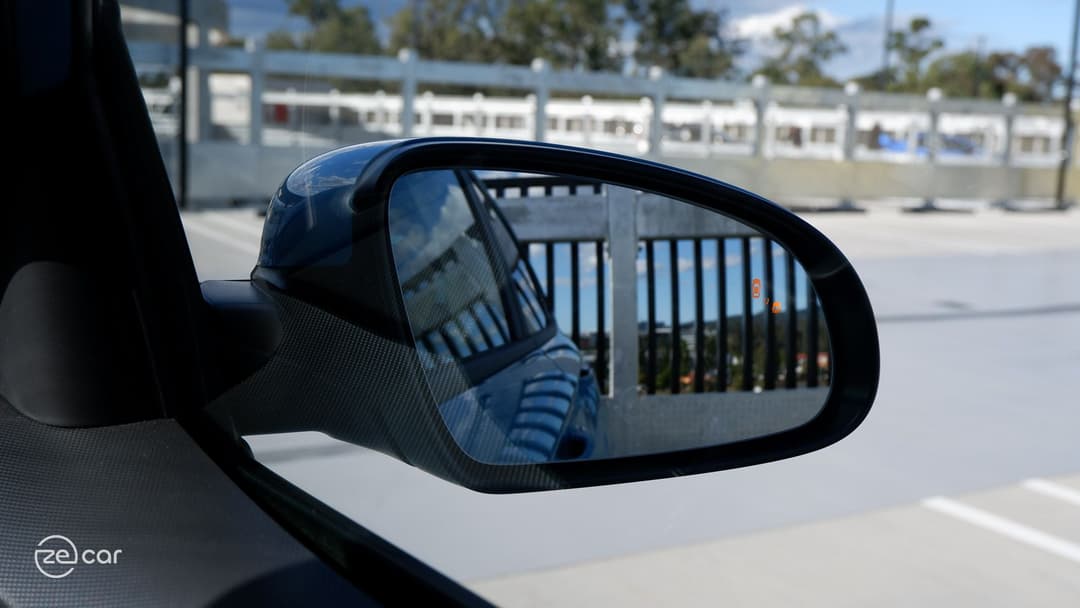
All Kona Electric’s come standard with Hyundai’s complete suite of active safety assistance systems, including auto emergency braking, lane-following, blind-spot and rear-cross avoidance assist, adaptive cruise control, safe exit warning and more.
Notably, lane-following sometimes keeps the EV in the middle of its lane by actively controlling the steering wheel. At other times, it tends to hug one side of the lane markings and I needed to constantly tug the wheel against its will. A button on the steering wheel can easily toggle it off.
It works in tandem with the stop/start adaptive cruise control that is easy to enable/disable, detects vehicles, and maintains the set speed limit well with configurable reaction sensitivity settings. However, in situations where the vehicle in front is on a slight crest or turn angle, it tends to detect too late, requiring immediate driver intervention.
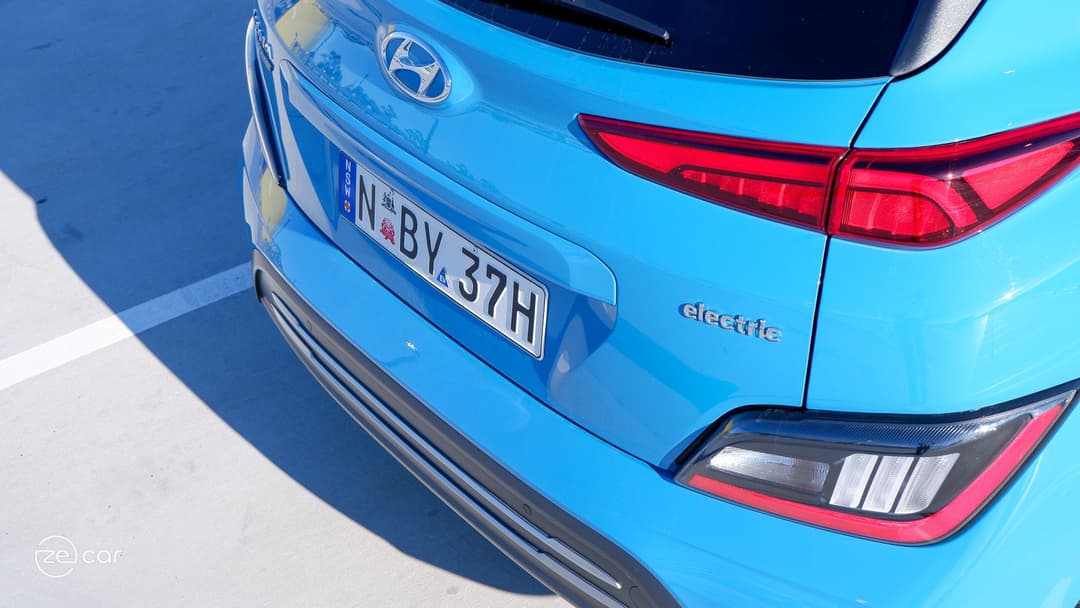
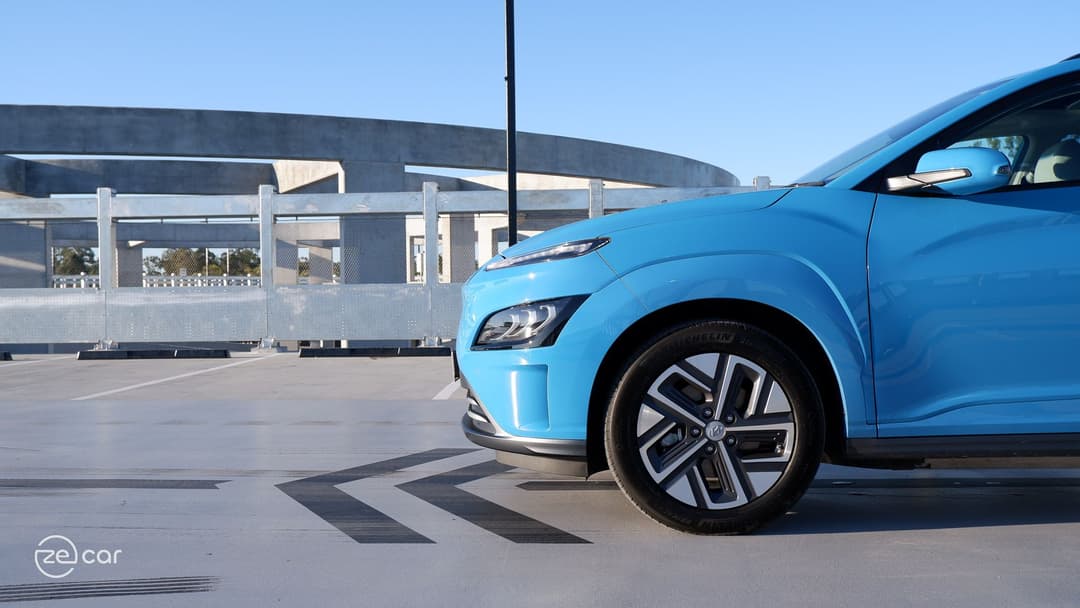
The rear-cross traffic alert and avoidance also came in handy several times when the small electric SUV is wedged between two large SUVs or when another car is driving too quickly in the carpark, thankfully pulling the brakes on to prevent a potential accident.
No, the Kona Electric doesn’t have a 360-degree surround view camera system nor blind spot view cameras like the flashier Ioniq 5, but the reversing camera is clear enough and the front parking sensors (exclusive on this Highlander model) is an important safety addition.
Similarly, only this top-spec Highlander features full all-round LED lights. The auto high beam LED headlights provide a good spread at night and the LED indicators flash prominently at the front and rear.
Range and charging
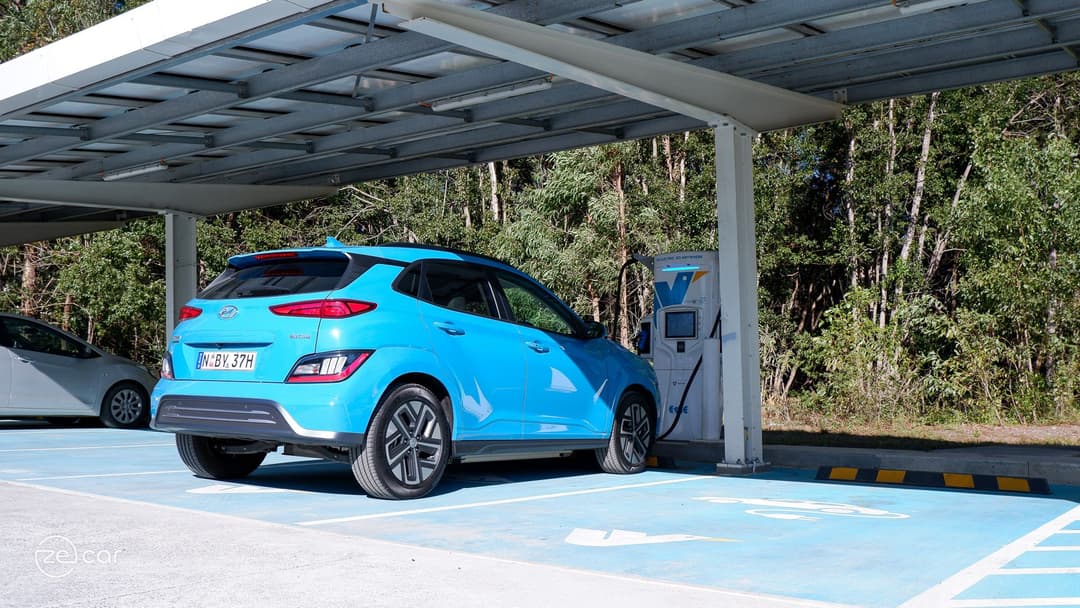
The Kona Electric Extended Range features a larger 64kWh (usable) lithium-ion battery that can be recharged at up to 100kW DC or 7.2kW AC speeds via its onboard charger and Type 2/CCS2 port.
In our testing, we only achieved a peak of 77kW on an ultra rapid 350kW capable public DC charging station – and went from 16 per cent to 80 per cent in 52 minutes.
That’s enough time to rest or eat without the need to rush, unlike other EV models with more impressive DC charging times. If you’re always in a hurry, though, the Kona Electric is inconvenient, but frequent rapid charging isn’t good for the long-term health of the battery anyway.
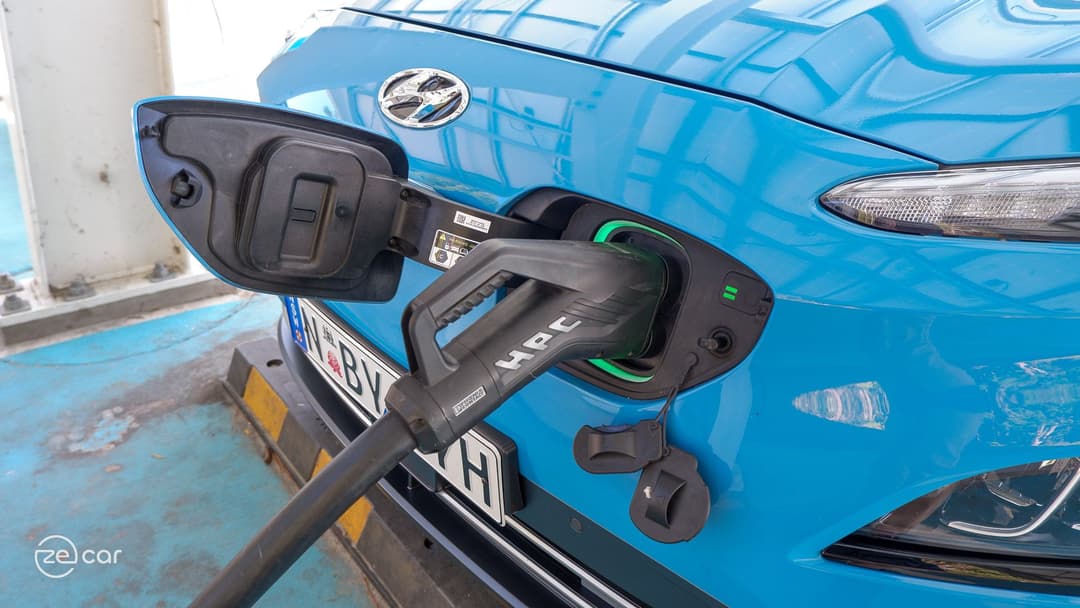
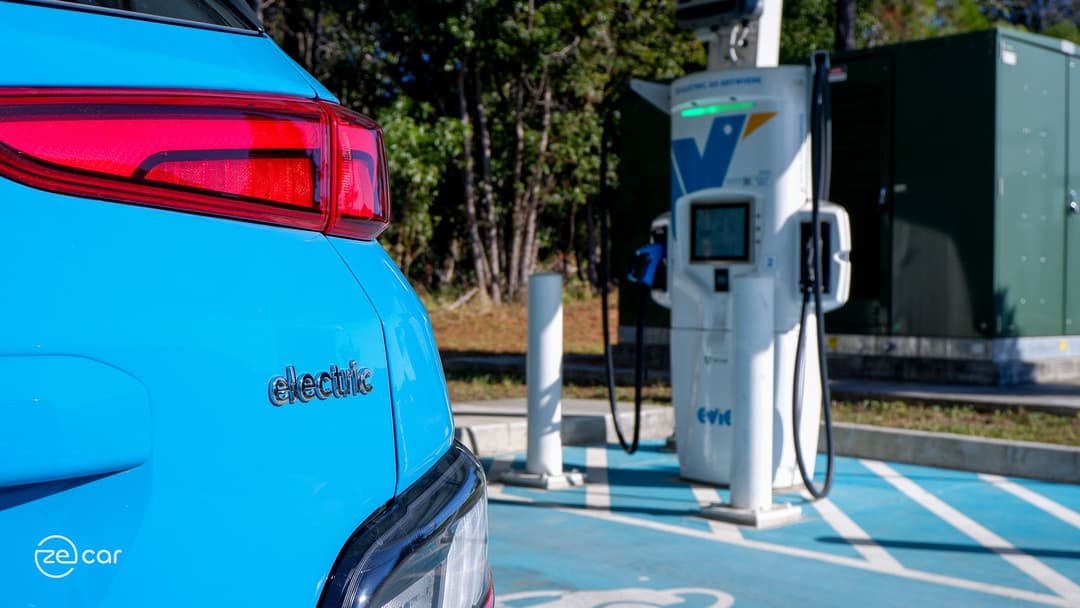
It’s worth noting that the battery was cooled down after a highway drive in the Queensland winter climate, which explains why the first 18 minutes of charging was capped at around 50kW before ramping up due to a hotter battery pack.
A lower state of charge starting point (under 10 per cent) could’ve also improved the charging time.
Additionally, its limited charging capabilities are most noticeable on AC. While it’s not a fuss for home charging from a powerpoint or wallbox overnight, the Kona’s 7.2kW AC cap means it can’t unlock the full capabilities of many public AC stations at 11kW or more.
Hyundai claims this larger Extended Range battery can travel 484km (WLTP).
In my week with the Kona Electric Highlander Extended Range, I was driving mostly on highways with some urban commuting, in normal and sport modes, numerous acceleration punches, and regenerative braking intensity set to the strongest level three auto.
As a result, I achieved an average of 135Wh/km energy consumption. This translates to 474km of real-world tested range.
If my driving was more reflective of the roughly 50/50 split between urban/highway driving under WLTP testing, this range would likely have exceeded 500km.
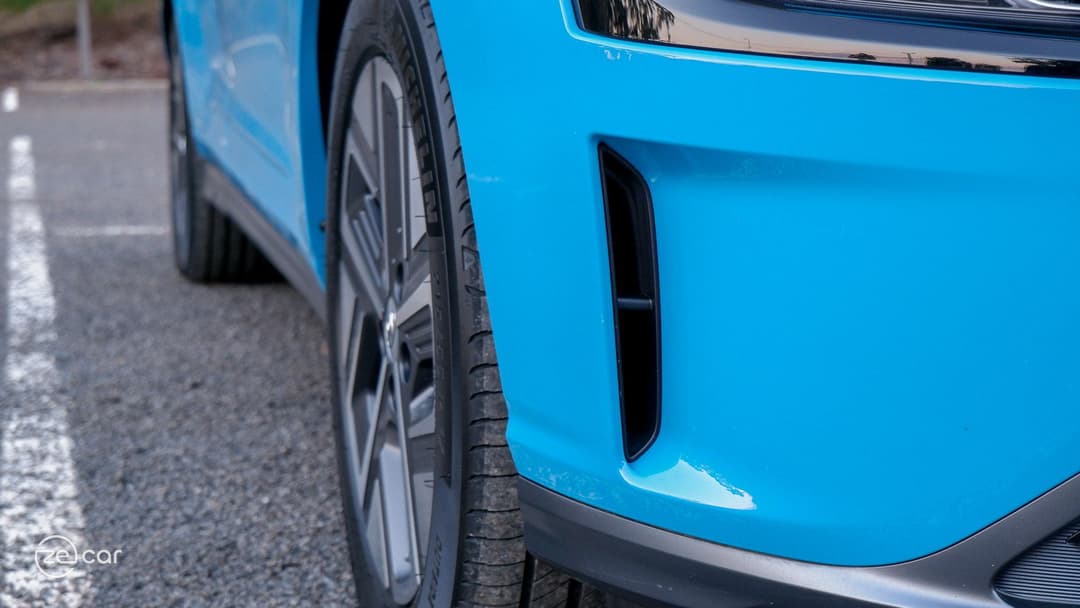
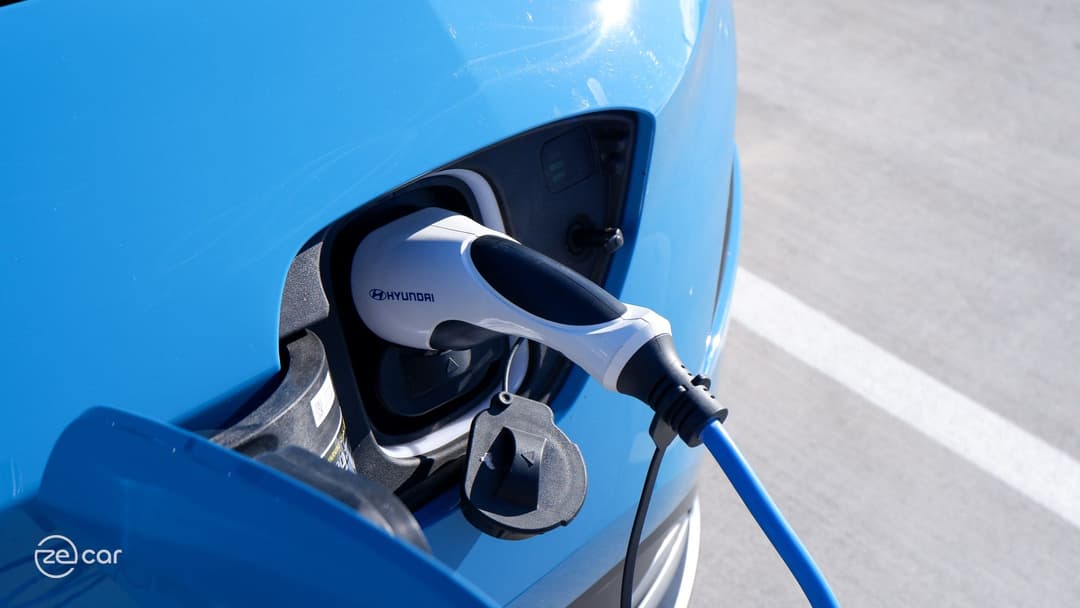
These are impressive figures that almost match the claim, especially for an EV based on internal combustion engine underpinnings dating back to 2018 and a body that isn’t as aerodynamically shaped.
Though, it’s helped by the facelift’s use of a low rolling resistance Michelin Primacy4 eco tyre, functional air ducts and smooth front end.
I suspect a lighter right foot, more low speed city driving and the Standard Range battery guise with a less powerful electric motor will improve energy efficiency even further.
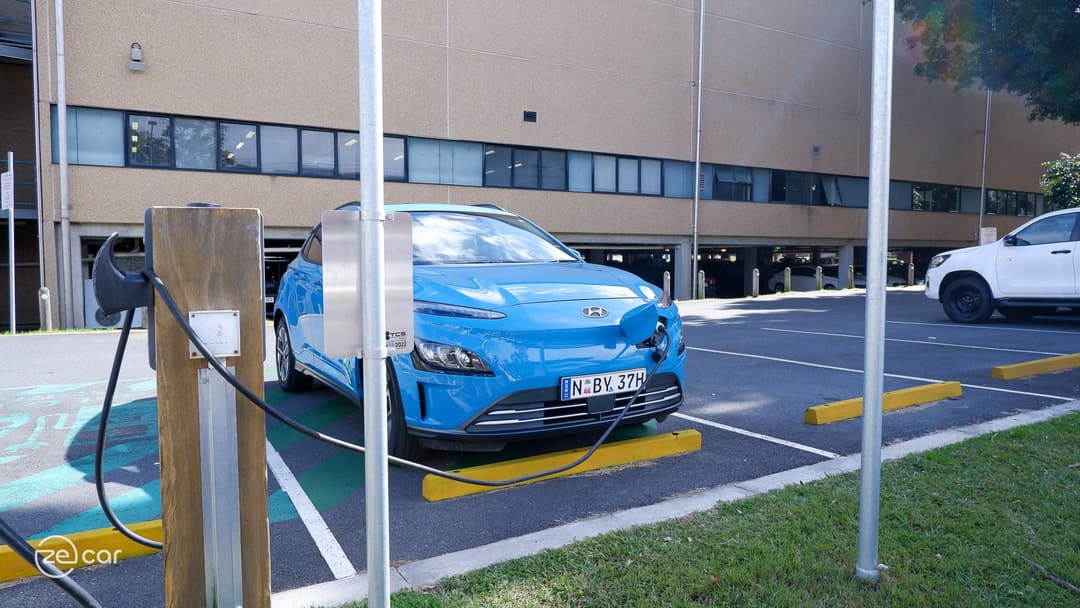
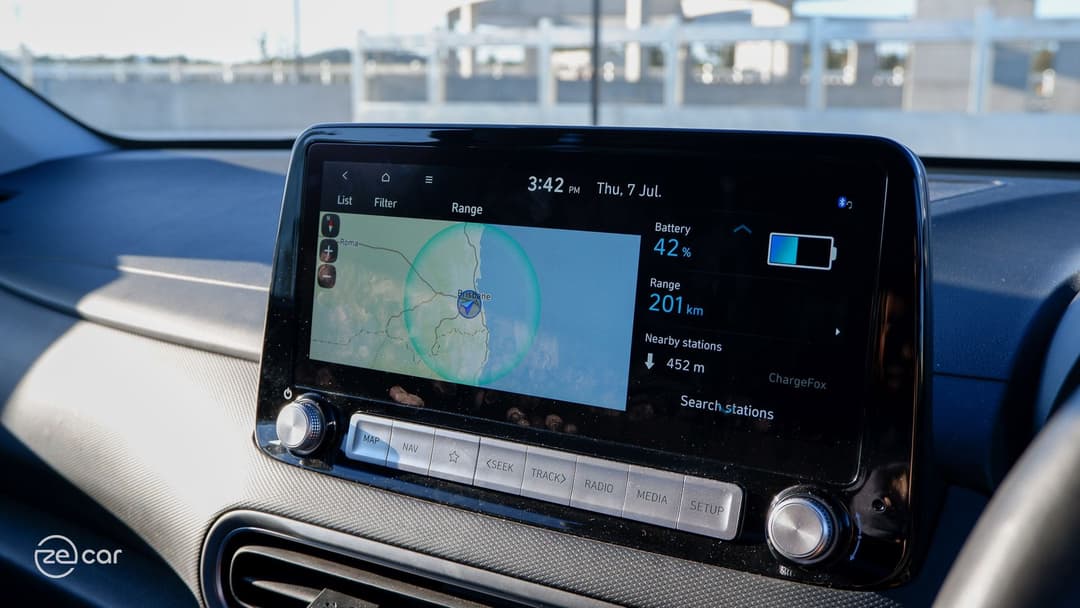
The Kona Electric’s charging port is placed at the front-left side of the vehicle’s face. It’s easy to open and close as a manual, spring-loaded charging flap. However, the two caps covering the Type 2 port and bottom CCS2 tend to tangle its strings together.
The location of the charging port means driver’s will need to drive-in to most public EV charging station spots, though it can be a struggle for the cable to reach if the stall is positioned on the side.
Driving
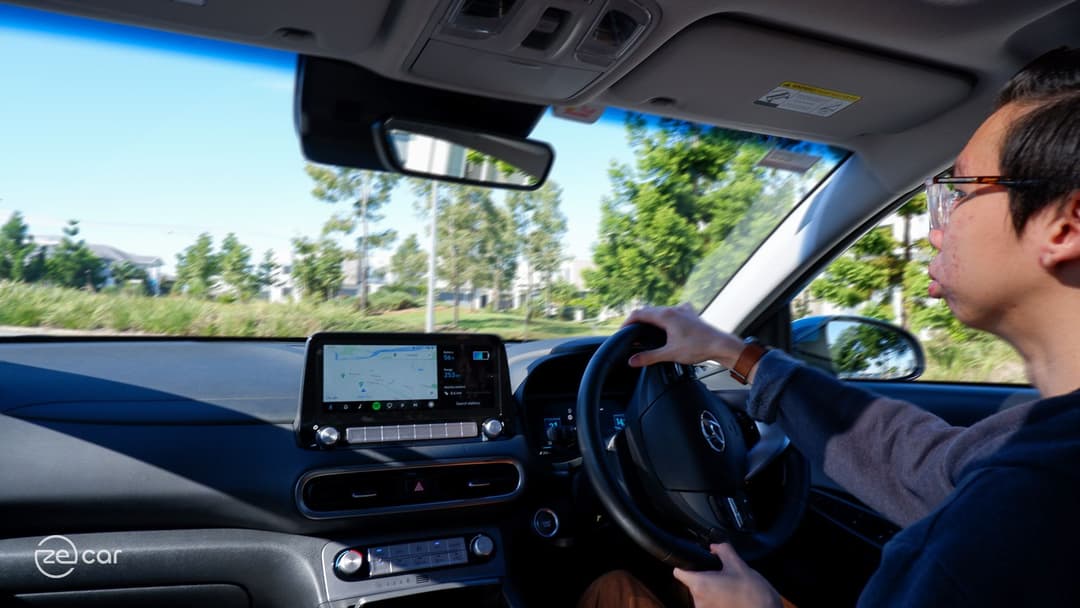
The Kona Electric Highlander Extended Range has a single electric motor driving the front wheels exclusively, with 150kW of power and 395Nm of torque delivering a claimed 7.9 second 0-100km/h time.
In the context of EVs, these aren’t impressive numbers; however, it still certainly feels fast with 100 per cent of torque instantly available. This means I could still accelerate quickly from a standstill (and leave other combustion cars in the rear view mirror) and have the confidence to briskly change lanes and merge onto highways.
The Kona Electric provides more than enough power for most typical drivers. But, due to the eco rubber and front-wheel drive (FWD) powertrain, it likes to squeal its tyres and lose traction if drivers floor the accelerator, especially when turning out of a corner and in sport mode. That’s not ideal (it makes a scene), though the silver lining is to temper the throttle and be a more efficient driver.
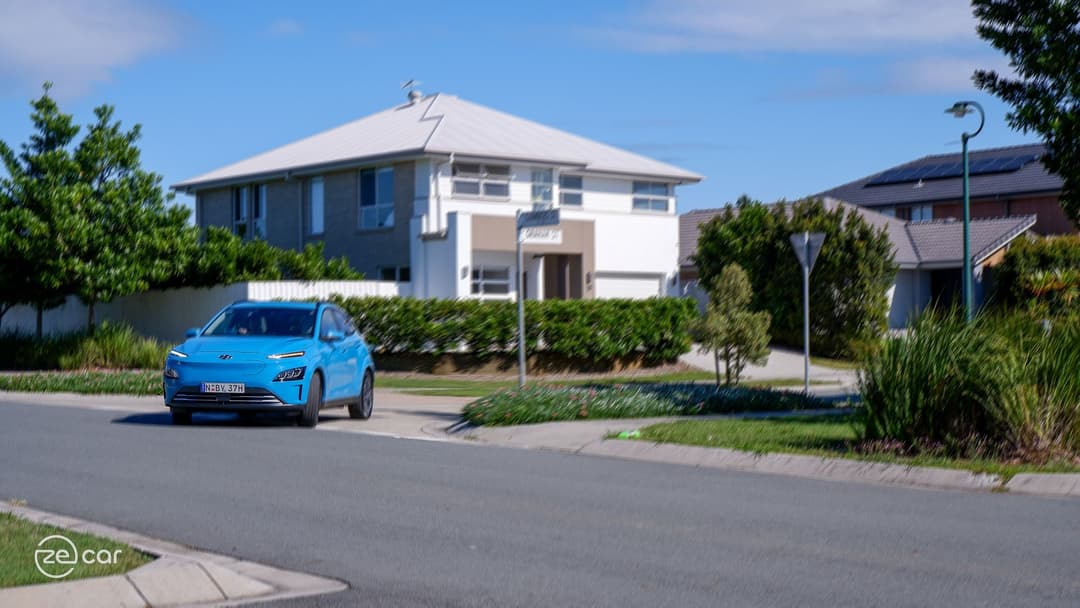
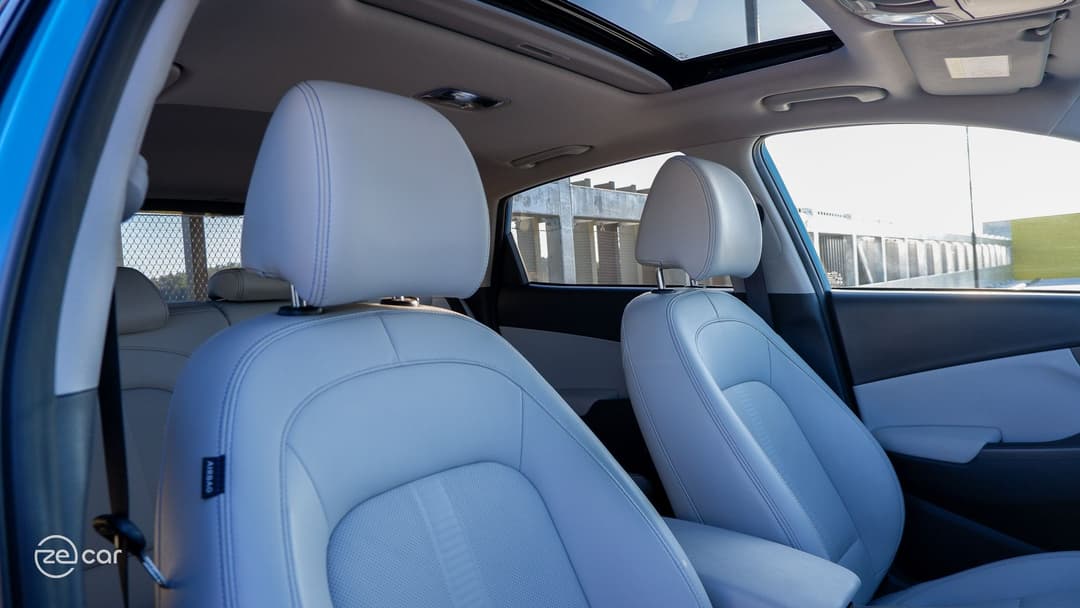
Overall, the small electric SUV drives well with a mostly compliant ride and suspension over bumps. Though, there is some body lean when turning more zealously and the cabin isn’t as isolated from outside noises, wind and coarse chip roads.
Furthermore, the front electric motor and exterior pedestrian warning sound delivered nice futuristic whirring sounds.
In a world of ever-growing SUVs, it’s a relief to drive the Kona Electric’s compact dimensions at 4205mm long, 1800mm wide and 1570mm high, with a 158mm ground clearance and 10.4-metre turning circle.
It’s a great size EV for city driving – navigating tight shopping centre car parks, reverse parking in suburban streets and driving through narrow lanes are all less stressful. However, it seems the next-generation Kona is set to grow larger.
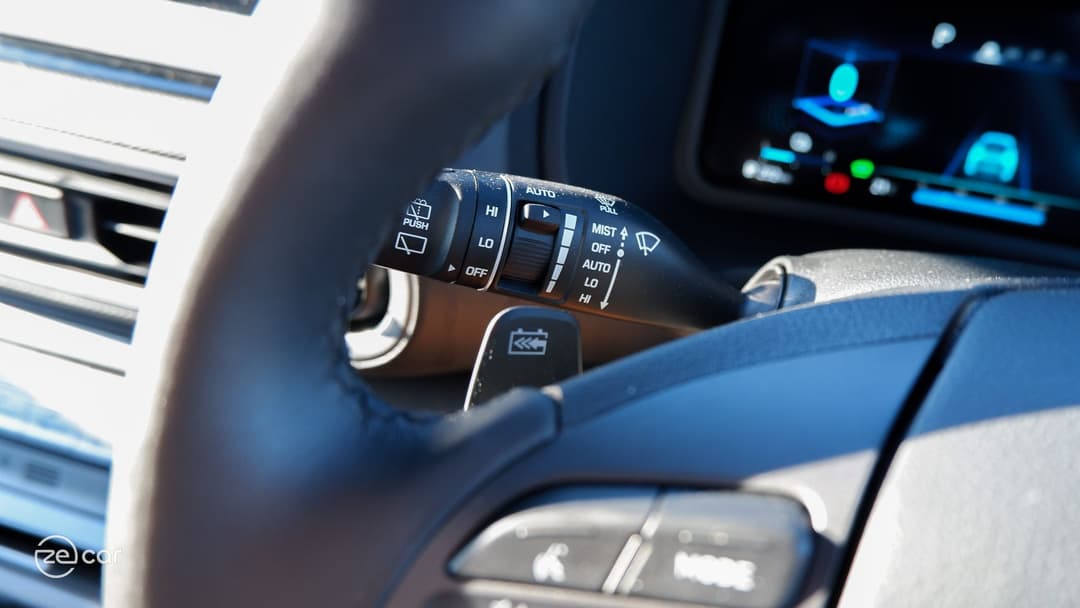
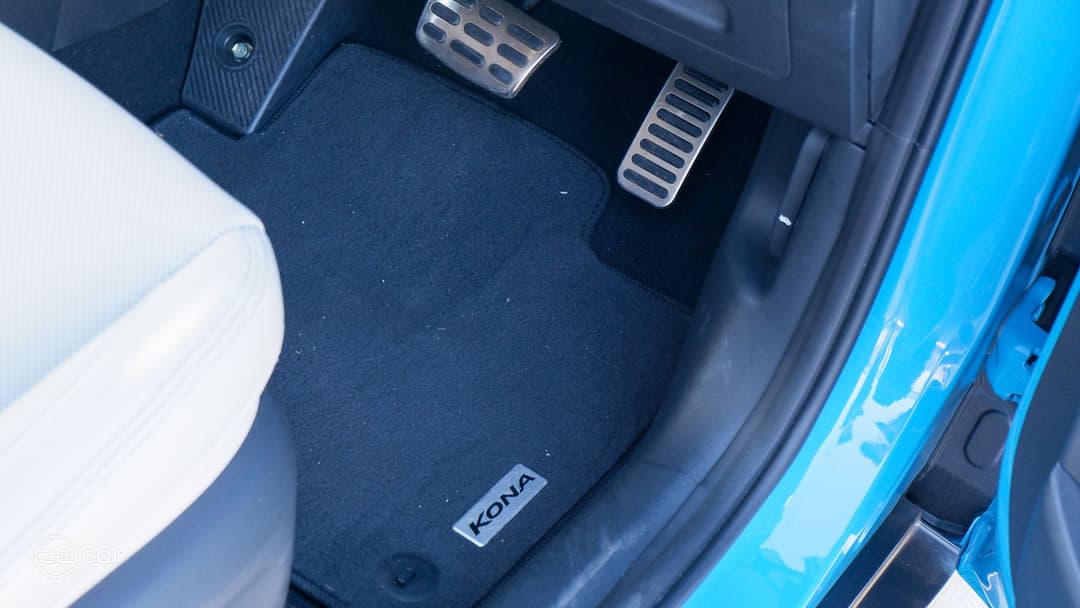
Unlike newer EV models from the South Korean automaker, the Kona Electric only offers three levels of regenerative braking intensities which can all be set on an adaptive automatic mode. There’s no one pedal driving here, but driver’s can hold the left paddle shifter to make the vehicle come to a gradual stop.
It also doesn’t activate the brake lights and auto hold once completely stopped, requiring the driver to still tap the brake pedal.
Using level three auto recuperation, and a combination of the left paddle shifter and the brake pedal once it started to coast under 15km/h worked well for me.
Unlike our findings in the 2022 Kia EV6 review, the Kona Electric can thankfully change its default regen setting tied to each drive mode, making starting the vehicle every time much more seamless.
Verdict
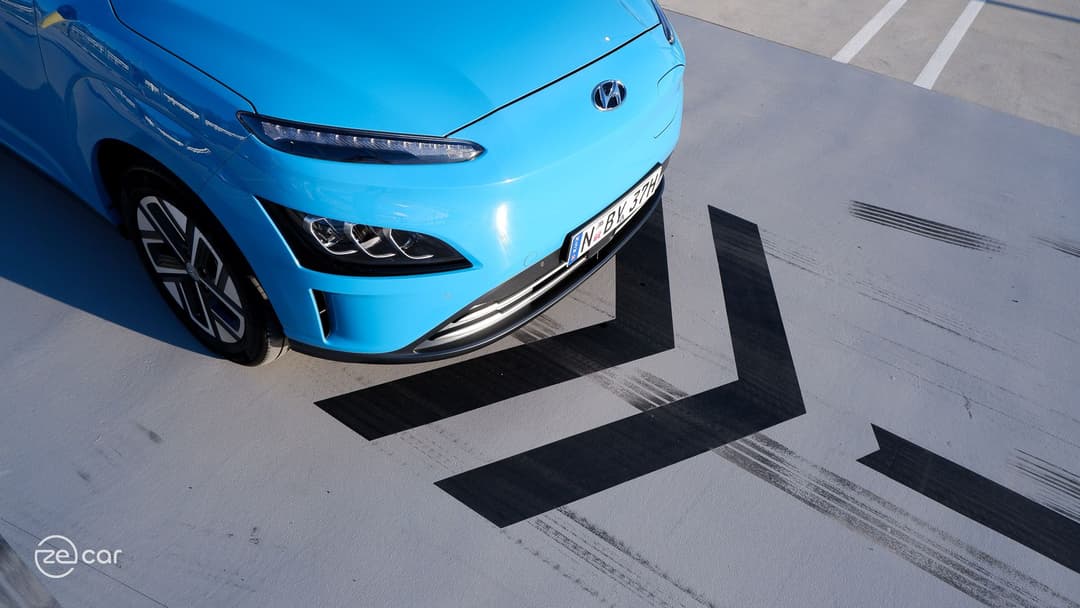
Sometimes, it’s the simple, non-pretentious cars that drive sales success and ownership satisfaction.
While the bespoke Hyundai Ioniq 5 may headline marketing collateral and move the EV game forward, the 2022 Hyundai Kona Electric Highlander Extended Range is a no-nonsense small electric SUV with tactile physical buttons, almost all tech and safety assist features you could ever need, and delivers impressive efficiency and driving range.
Although its size is great for urban driving, it doesn’t suit always having passengers in the rear row. Some buyers might also find the FWD instant power and loss of traction disconcerting.
It’s worth looking into the $16,000 cheaper Standard Range battery model as not all buyers need the extra range for typical daily commutes. But, I’d recommend opting for the high-spec Highlander to gain key features like LED lights (instead of dim halogens), heated/ventilated seats (instead of using the air-con to extend range) and more over the Elite.
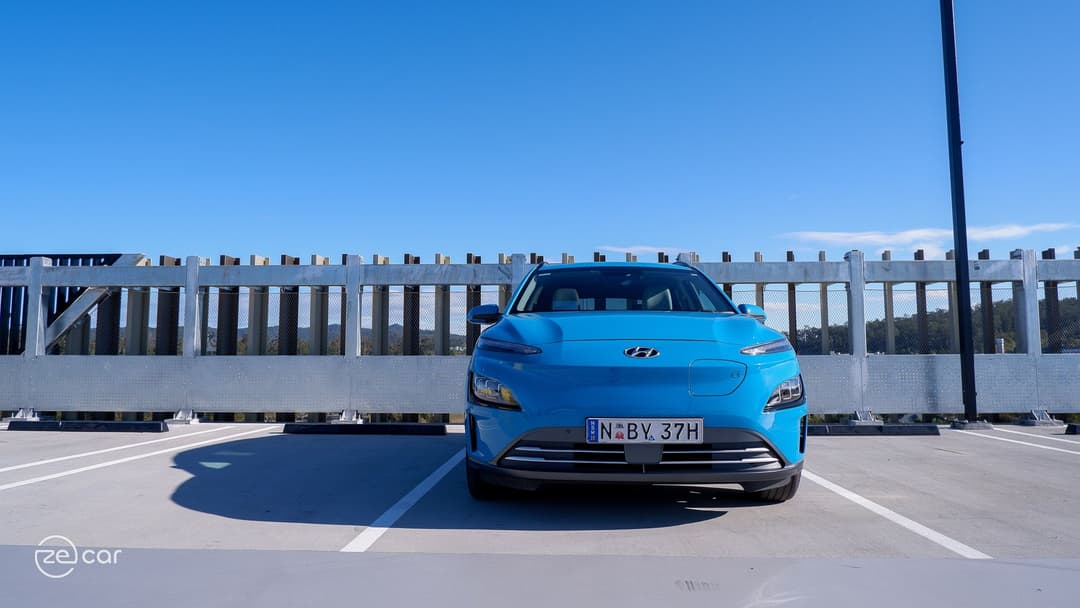
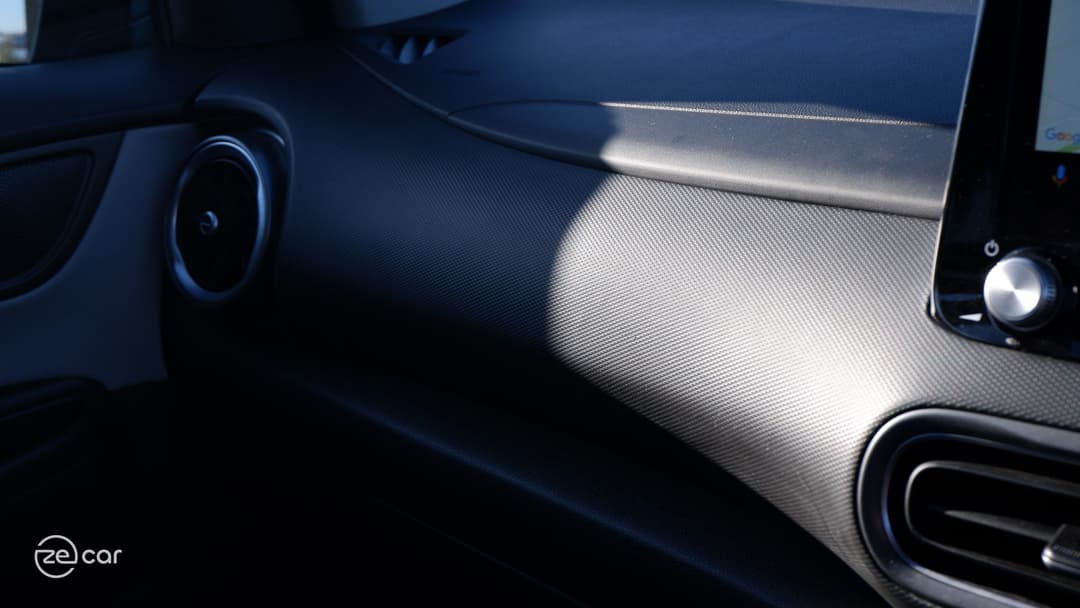
Sadly, the fierce EV competition has moved a step ahead.
The Chinese-born BYD Atto 3 Extended Range and MG ZS EV Essence are substantially cheaper at around $50K and more practical crossover SUVs. Meanwhile, the slightly more expensive all-new Kia Niro EV is also more spacious with a longer vehicle warranty, and the base Tesla Model Y offer head-turning features on a dedicated EV platform at about $72K.
It’s easy to overlook the Hyundai Kona Electric. Yet, it’s a functional, feature-packed, highly efficient EV without trying to be too different and does the A to B job without fuss (and emissions). After all, it is the second-best selling EV so far this year for a reason.
Datawrappers by Danny Thai
Photographs by Henry Man
About the author
Stay up to date with the latest EV news
- Get the latest news and update
- New EV model releases
- Get money savings-deal




